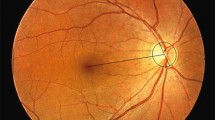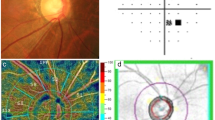Summary
At the earliest stage of clinical detection of open-angle glaucoma with visual field defect namely that of initial diagnosis prior to significant symptoms, one can already demonstrate a significant deviation of the distribution of C/D ratio from that of individuals with similar pressure readings who are free from glaucomatous visual field defect. This difference consists of a markedly reduced frequency of small C/D values in glaucomatous eyes and a great increase in large C/D values.
In addition, one can demonstrate at this stage enlargement of the optic cup as evidenced by the increased frequency of a difference between the ratios of the two eyes which is > 0.2. In general, the C/D ratio was greater in the affected eye in monocular involvement and in the eye with greater field defect. It is hypothesized that the C/D ratio is one of the factors involved in determining the vulnerability of the visual field to higher ocular pressure in openangle glaucoma. This relationship results in a great increase in the relative frequency of involvement of the visual field by the glaucomatous process in eyes with large C/D ratios and a reduction of that frequency in eyes with small C/D ratios. It was also hypothesized that different sets of factors operate in the production of field defect in eyes with different C/D ratios.
From the clinical standpoint, the findings emphasize the importance of ophthalmoscopic evaluation of the optic nerve in the early suspicion and detection of open-angle glaucoma. This evaluation should include a careful estimation, recording and monitoring in time the characteristics of the optic cup.
Résumé
Dès la découverte d'un glaucome à angle ouvert présentant des anomalies du champ visuel sans autres symptomes significatifs, on peut démontrer que le rapport diamètre horizontal de l'excavation: diamètre horizontal de la papille (C/D) diffère de celui constaté chez des sujets ayant une pression oculaire analogue, mais aucune altération périmétrique, caractéristique du glaucome. Dans les premiers cas les petites valeurs du C/D sont beaucoup plus rares; les valeurs élevées y deviennent plus fréquentes.
De plus, on peut dès ce stade mettre en évidence un élargissement de l'excavation, étant donné que le rapport C/D à un oeil dépasse plus souvent celui de l'oeil adelphe de plus de 0,2. C'est en général l'oeil le plus atteint qui présente le rapport le plus élévé.
On peut supposer que le rapport C/D joue un rôle dans la vulnérabilité du champ visuel soumis à des pressions intra-oculaires pathologiques. Ainsi s'expliquerait la relative fréquence des anomalies périmétriques dans des globes hypertendus ayant des C/D élevés et leur rareté en présence d'un rapport peu important. Toutefois, d'autres facteurs peuvent également intervenir. Quoiqu'il en soit, du point du clinique, l'évaluation ophtalmologique soigneuse du rapport C/D parait importante dès la suspicion ou la détection d'un glaucome à angle ouvert, comme au cours de son évolution.
Zusammenfassung
Es konnte gezeigt werden, daß schon in den Anfangsstadien eines Weitwinkelglaukoms mit Gesichtsfeldveränderungen das Verhältnis des horizontalen Durchmessers der Exkavation zum horizontalen Durchmesser der Papille (C/D) sich von dem unterscheidet, welches man bei Kranken mit gleichem Augendruck, aber ohne für Glaukom charakteristische perimetrische Störungen findet. Bei den ersteren sind die niedrigen C/D Werte viel seltener und die hohen Werte häufiger.
Außerdem läßt sich bereits in diesem Stadium eine Erweiterung der Exkavation dadurch nachweisen, daß an dem einem Auge der C/D Wert öfter um mehr als 0,2 größer ist als an dem anderen. Im allgemeinen entspricht der höhere Wert dem mehr erkrankten Auge.
Es scheint, daß der C/D Wert die Empfindlichkeit des Gesichtsfelds pathologischen Druckwerten gegenüber mitbestimmt. Dies würde die relative Häufigkeit von Gesichtsfelddefekten in Glaukomaugen mit hohen C/D Werten, wie auch die Seltenheit bei niedrigen Werten erklären. Man kann aber auch vermuten, daß noch andere Faktoren hierbei im Spiele sind.
Jedenfalls ist vom klinischen Standpunkt aus die genaue Aufstellung des C/D Wertes wichtig. Dieser sollte schon bei Glaukomverdacht oder bei der ersten Feststellung eines Weitwinkelglaukoms genau registriert und später regelmäßig beobachtet werden.
Similar content being viewed by others
References
Armaly, M. F. Genetic determination of cup disc ratio of the optic nerve,Arch. Ophthal. 78,35–43 (1967).
Armaly, M. F. Cup disc ratio and the findings of tonometry and tonography in the normal eye,Arch. Ophthal. (in press).
Armaly, M. F. The optic cup in the normal eye: I. Cup width, depth, vessel displacement, ocular pressure and outflow facility,Amer. J. Ophthal. (in press).
Armaly, M. F. The correlation between appearance of the optic cup and visual function,Trans. amer. Acad. Ophthal. Otolaryng. (in press).
Author information
Authors and Affiliations
Additional information
This investigation was supported in part by research grant CD-00017 from the National Center for Health Services Research and Development Health Services and Mental Health and NB-07328 from the National Institute of Neurological Diseases and Blindness, United States Public Health Service, Bethesda, Maryland.
Rights and permissions
About this article
Cite this article
Armaly, M.F. Cup/disc ratio in early open-angle glaucoma. Doc Ophthalmol 26, 526–533 (1969). https://doi.org/10.1007/BF00944008
Published:
Issue Date:
DOI: https://doi.org/10.1007/BF00944008




